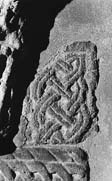Select a site alphabetically from the choices shown in the box below. Alternatively, browse sculptural examples using the Forward/Back buttons.
Chapters for this volume, along with copies of original in-text images, are available here.
Object type: Part of cross-shaft(?)
Measurements: L. 38 cm (15 in) W. 20 cm (7.9 in) D. Built in
Stone type: [Ancaster Freestone, Upper Lincolnshire Limestone, Inferior Oolite Group]
Plate numbers in printed volume: Ill. 71
Corpus volume reference: Vol 5 p. 119
(There may be more views or larger images available for this item. Click on the thumbnail image to view.)
Complete mid-wall shaft of slightly bulbous profile, in one stone. Either end is formed in a similar profile with a single roll and bell-shaped or conical expansion, but slightly asymmetrically, having a broader base than cap. Around the centre of its girth is a group of three rolls of slightly irregular execution.
Burton Pedwardine1 stands out from the other fragments amongst which it has been reset (nos. 2 and 3 below; Ill. 72), and, although its distinctiveness may be enhanced by its more weathered appearance, it cannot fit the mid-Kesteven cover interlace layout represented by nos. 2 and 3 (cf. Fig. 9). Furthermore, in contrast with the other stones from Burton Pedwardine, the more rounded style of interlace carving is not usual within the mid-Kesteven cover group. This fragment is perhaps more likely to have come from a standing cross-shaft and, if it is from such a monument, it might be compared with the shaft from Cranwell (no. 1, Ills. 105–7) which, like Burton Pedwardine1, is also associated with a major grave-cover. The well-rounded style of interlace cutting also connects the Burton fragment with the Cranwell shaft.
Burton Pedwardine1 may therefore be a fragment from a cross-shaft set upright in association with one of the two major grave-covers represented by the other fragments at this church (nos. 2 and 3 below). The Cranwell 1 shaft is dated to the mid-tenth century (p. 136) and this may allow the suggestion that the monument represented by Burton Pedwardine1 is of tenth- rather than eleventh-century date.



